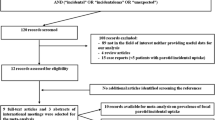Abstract
Purpose
We investigated PET/CT diagnostic criteria for differentiating benign from malignant parotid lesions with focal 18F-FDG uptake.
Methods
The subjects of the study were 272 patients who exhibited focal 18F-FDG uptake of the parotid gland. Sixty-eight pathologically confirmed parotid lesions from 67 patients were included. The maximum SUV (SUVmax), uptake patterns (homogeneous vs. heterogeneous), size measured by CT, maximum Hounsfield units (HUmax) and margins on CT (well vs. ill defined) of each parotid lesion on PET/CT images were compared with final diagnoses.
Results
Thirty-two parotid lesions were histologically proven to be malignant. There were significant differences in uptake patterns (cancer incidence, heterogeneous:homogeneous = 79.2%:29.5%, p < 0.0001) and margins on CT (cancer incidence, ill:well defined = 84.4%:13.3%, p < 0.0001) between benign and malignant lesions. The cancer risks of parotid lesions were 89.5% with heterogeneous uptake and ill-defined margins, 70.6% with heterogeneous uptake or ill-defined margins (no overlap in subjects) and 9.3% with homogeneous uptake and well-defined margins (p < 0.0001). When any lesion with heterogeneous uptake or ill-defined margins was regarded as malignant, the sensitivity, specificity, positive predictive value, negative predictive value and accuracy were 90.6% (29/32), 80.6% (29/36), 80.6% (29/36), 90.6% (29/32) and 85.6% (58/68), respectively. For predicting malignancy, combined PET/CT criteria showed better sensitivity, NPV and accuracy than PET-only criteria, and had a tendency to have more accurate results than CT-only criteria. There were no significant differences in SUVmax, size or HUmax between benign and malignant lesions.
Conclusion
Uptake patterns and margins on CT are useful PET/CT diagnostic criteria for differentiating benign from malignant lesions.


Similar content being viewed by others
References
Eveson JW, Cawson RA. Salivary gland tumours. A review of 2410 cases with particular reference to histological types, site, age and sex distribution. J Pathol. 1985;146:51–8.
Devita Jr VT, Hellman S, Rosenberg S. Cancer principles & practice of oncology. 7th ed. Philadelphia, PA: Lippincott Wiliam & Wilkins; 2005. p. 722–6.
van der Wal JE, Leverstein H, Snow GB, Kraaijenhagen HA, van der Waal I. Parotid gland tumors: histologic reevaluation and reclassification of 478 cases. Head Neck. 1998;20:204–7.
Seifert G, Sobin L. WHO International histological classification of tumours. Histological typing of salivary gland tumours. 2nd ed. Heidelberg: Springer Verlag; 1991.
Speight PM, Barrett AW. Salivary gland tumours. Oral Dis. 2002;8:229–40.
Keyes Jr JW, Harkness BA, Greven KM, Williams DW, Watson NE, Frederick-Mcguirt W. Salivary gland tumors: pretherapy evaluation with PET. Radiology. 1994;192:99–102.
Uchida Y, Minoshima S, Kawata T, Motoori K, Nakano K, Kazama T, et al. Diagnostic value of FDG PET and salivary gland scintigraphy for parotid tumors. Clin Nucl Med. 2005;30:170–6.
Okamura T, Kawabe J, Koyama K, Ochi H, Yamada R, Sakamoto H, et al. Fluorine-18 Flourodeoxyglucose positron emission tomography imaging of parotid mass lesions. Acta Otolaryngol Suppl. 1998;538:209–13.
Rubello D, Nanni C, Castellucci P, Rampin L, Farsad M, Franchi R, et al. Does 18F-FDG PET/CT play a role in the differential diagnosis of parotid masses. Panminerva Med. 2005;47:187–9.
Basu S, Houseni M, Alavi A. Significance of incidental fluorodeoxyglucose uptake in the parotid glands and its impact on patient management. Nucl Med Commun. 2008;29:367–73.
Wang H, Zuo C, Hua F, Huang Z, Tan H, Zhao J, et al. Efficacy of conventional whole-body 18F-FDG PET/CT in the incidental findings of parotid masses. Ann Nucl Med. 2010;24:571–7.
Ozawa N, Okamura T, Koyama K, Nakayama K, Kawabe J, Shiomi S, et al. Retrospective review: usefulness of a number of imaging modalities including CT, MRI, technetium-99 m pertechnetate scintigraphy, gallium-67 scintigraphy and F-18-FDG PET in the differentiation of benign from malignant parotid masses. Radiat Med. 2006;24:41–9.
Tixier F, Rest CCL, Hatt M, Albarghach N, Pradier O, Metges JP, et al. Intratumor heterogeneity characterized by textural features on baseline 18F-FDG PET images predicts response to concomitant radiochemotherapy in esophageal cancer. J Nucl Med. 2011;52:369–78.
Basu S, Kwee TC, Gatenby R, Sabuory B, Torigian DA, Alavi A. Evolving role of molecular imaging with PET in detecting and characterizing heterogeneity of cancer tissue at the primary and metastatic sites, a plausible explanation for failed attempts to cure malignant disorders. Eur J Nucl Med Mol Imaging. 2011. doi:10.1007/s00259-011-1787-z.
Frederick-Mcguirt W, Keyes Jr JW, Greven KM, Wiliams III DW, Watson Jr NE, Cappellari JO. Preoperative identification of benign versus malignant parotid masses: a comparative study including positron emission tomography. Laryngoscope. 1995;105:579–84.
Berg HM, Jacobs JB, Kaufman D, Reede DL. Correlation of fine needle aspiration biopsy and CT scanning of parotid masses. Laryngoscope. 1986;96:1357–62.
Choi JY, Lee KS, Kwon OJ, Shim YM, Baek CH, Park K, et al. Improved detection of second primary cancer using integrated [18F] fluorodeoxyglucose positron emission tomography and computed tomography for initial tumor staging. J Clin Oncol. 2005;23:7654–9.
Conflict of interest
The authors have no conflicts of interest to declare.
Author information
Authors and Affiliations
Corresponding author
Electronic supplementary material
Below is the link to the electronic supplementary material.
Supplementary Table 1
Comparisons of clinical and PET/CT findings between benign and malignant focal parotid lesions detected on 18F-FDG PET/CT in LS scanner subgroup. (DOCX 23.7 kb)
Supplementary Table 2
Comparisons of clinical and PET/CT findings between benign and malignant focal parotid lesions detected on 18F-FDG PET/CT in STe scanner subgroup. (DOCX 23 kb)
Rights and permissions
About this article
Cite this article
Park, S.B., Choi, J.Y., Lee, E.J. et al. Diagnostic Criteria on 18F-FDG PET/CT for Differentiating Benign from Malignant Focal Hypermetabolic Lesions of Parotid Gland. Nucl Med Mol Imaging 46, 95–101 (2012). https://doi.org/10.1007/s13139-012-0135-y
Received:
Revised:
Accepted:
Published:
Issue Date:
DOI: https://doi.org/10.1007/s13139-012-0135-y




